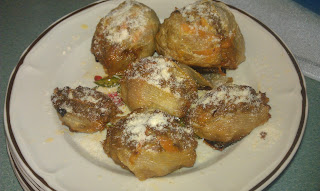Ever been sitting around the campfire, having a beer or glass of wine and get an urge for a snack? S'mores are great fun but don't go real well with beer (actually they go pretty well with wine, in my opinion. ) On one such night I tried to imagine how some of our favorite snacks could become campfire favorites and the next day I came upon these photos of nachos and knew this would fill the snack void during our next campfire. Everyone loves nachos and this easy method is so adaptable that it can accommodate anyone's fancy. I adapted the recipe by combining several others and the photos are from a pinterest pin that credited The Inspired Dreamer blog (http://inspiredreamer.com)
You can almost make it just from the photos but here are some ingredients and directions.
Ingredients
- FOR THE GARLIC CREAM SAUCE: or use a jar of prepared Ranch or Alfredo sauce
- 1-½ Tablespoon Butter
- ½ Tablespoons Olive Oil
- 3 cloves Garlic, Minced
- ½ cups Heavy Cream(I substitute plain Greek yogurt but it has a little more tart flavor)
- ¼ cups Milk
- Salt and pepper
- 1 pinch Red Pepper Flakes
- ¼ cups Parmesan Cheese, Grated
- FOR THE NACHOS:
- Tortilla Chips
- ½ cups Garlic Cream Sauce (above)or use a jar of prepared Ranch or Alfredo sauce
- ¼ cups Onion, Diced
- ½ lb cooked hamburger or sausage meat (I brown it in advance and freeze in baggies) As an alternative you could use pepperoni, shredded chicken or a can of beans, rinsed
- ½ cups Black Olives Sliced
- ½ Green Bell Pepper, Diced
- 1 cup favorite shredded cheese
- Sliced jalapenos
Melt the butter in a sauce pan. Make a roux by adding the Parmesan cheese to the melted butter and blend. Add in the cream and milk stirring constantly till blended. Add in remaining sauce ingredients. Simmer on low do not boil.
Layer the chips in a dutch oven (or any pan that can withstand the heat of an oven/campfire,) pour sauce over chips and layer remaining nacho ingredients.
Heat in a 350F oven or place over coals till cheese is melted. If you cook on coals remember to have fireproof mitts or pot holders for dutch oven.
Have some tongs or a flat scoop nearby and dish the nachos onto paper plates. Bet there won't be any leftovers!














